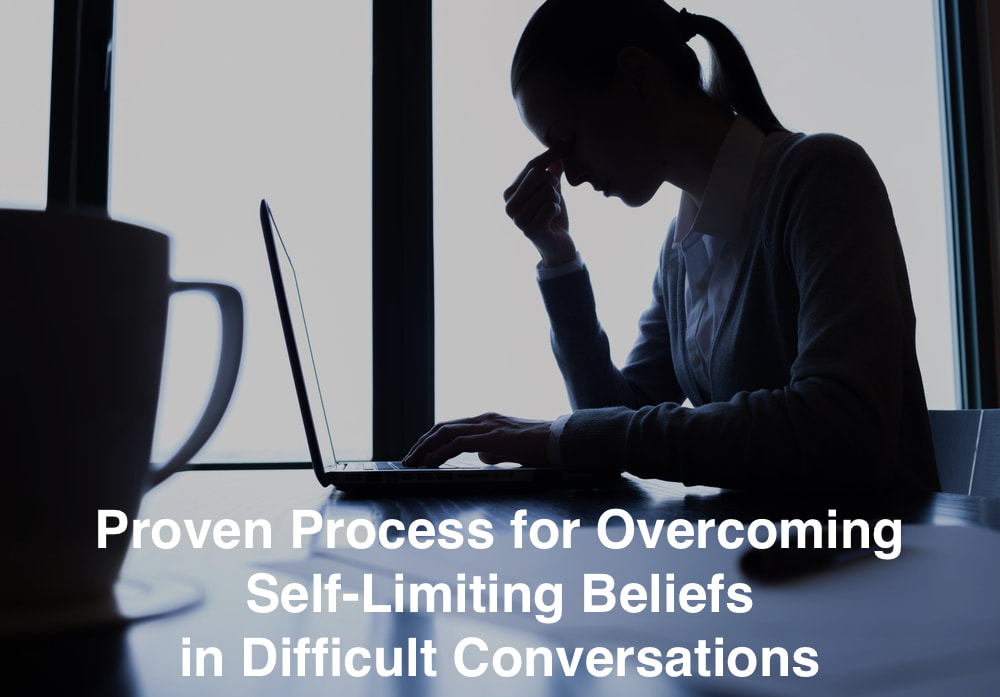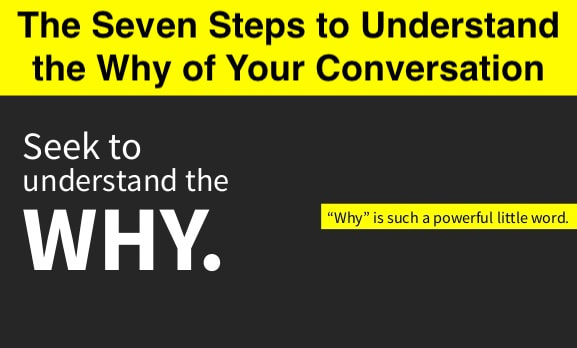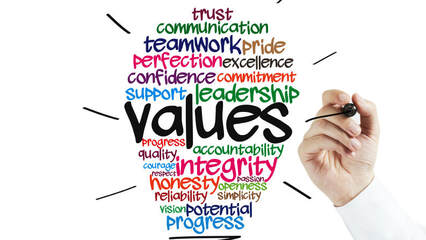Proven Process for Overcoming Self-Limiting Beliefs in Difficult Conversation Have you ever been extremely determined to speak with someone about something upsetting you but slowly “chickened out” or found yourself coming up with a thousand reasons why not to say anything? It may sound like: “I don’t want to hurt their feelings”, “They got really angry and yelled at me last time”, or “You won’t be able to be professional in your delivery. You will probably cry”.
The Learning Laboratory That little voice inside you is simply the fear center of your brain holding onto old beliefs that no longer serve you. It is time to learn to overcome those fears, be bold, be courageous and discover that difficult conversations are nothing more than simple dialogues designed to build relationships, develop trust and grow with one another. As you begin to approach taking action on your difficult conversation, you may find that your thoughts, feelings, opinions, beliefs, attitudes, memories, body sensations and points of view are in the way of moving ahead. And, we must know that this is completely normal. All of us go through the same self-limiting conversations, recall of harmful experiences and plethora of negative assumptions. That is why Step 2: Getting the Schmutz Out of the Way is all about overcoming these internal obstacles to set ourselves up for a successful, growth-producing conversation. Coaching Tips We begin with a simple exercise aimed at uncovering these opinions, thoughts and beliefs that are getting in the way of seeing something clearly.
0 Comments
New Research Reveals The True Impact of Conversations Throughout our lives, we hold millions and millions, perhaps even billions, of conversations. British writer, Gyles Brandreth, once calculated that we speak 860,341,500 words in a lifetime1. Many of these conversations flow naturally with ease. Others may be confusing, exciting, intriguing, saddening, frightening, and so much more. But the ones that are most memorable oftentimes fit into two simple categories: positive and negative.
The positive conversations consist of concepts like life advice, “kicks in the butt”, loving messages, caring gestures and a listening ear. The negative conversations, though, are made up of tough feedback, difficult news, challenging conflict and harmful consequences. Research, widely accepted on negativity bias, from Rozin and Royzman says “organisms are genetically predisposed toward greater weighting and attention to negative events“4 Therefore, if it is a negative conversation, it will leave a lasting impact on our relationships, our perspective and, most importantly, our brain. Some have gone as far as to claim that negative experiences have an impact that is 3x stronger than positive experiences3. So why do we care? Conversations are no longer just a way of sharing information. Through our evolution and breakthroughs in research, we now know that conversations trigger changes: physical, chemical and emotional, inside our bodies and brains. Therefore, if negative conversations have a greater impact on us than positive ones and our actual brains and neurochemistry change during conversations, we must make specific modifications to the way we hold conversations, deliver feedback and facilitate those difficult ever day conversations. However, the problem is simple: oftentimes in school, at home and within the workplace, we never truly learn how to communicate or how to convey difficult news. According to Conversational Intelligence, “conversations are the way we connect, engage, navigate, and transform the world with others”2. If this is true, then we must teach ourselves, our workplaces, our communities and our children how to communicate, more specifically how to deliver difficult conversations, in a way that cuts down on defensiveness, garners a growth mindset and diminishes the impact of negativity bias. The Learning Laboratory Years ago, we were working with a young director with ambition, promise and one glaring problem: her communication skills. She had built quite a reputation for being overly stern, impatient with others and blunt in her feedback. When placed in one-on-one coaching, we embarked on a journey with one objective in mind: develop the ability to have uncomfortable conversations with candor, compassion and courage. Now, fast forward months into our coaching partnership, this driven individual was tasked with one of her toughest conversations yet, and she wasn’t backing down. As she brought the situation to our coaching session, all of the joy, curiosity and energy sparked inside of me. After months of intense coaching and practice, she was finally going to utilize everything we have learned throughout our journey together. Coaching Tips This process for navigating difficult conversations has culminated from decades of experience and work with executives, leaders and managers from every industry across the nation, none more impactful than this client. As we embark on this journey together, this client and her example will provide key learnings and application of the process.
The Seven Steps to Understand the Why of Your Conversation Have you ever walked into a conversation or meeting and had no idea what you were there to do? Has your spouse ever said, “go deal with your child” and you didn’t even know what they had done?
These may seem like excess examples, but these types of situations happen to us all the time in varying degrees. Sometimes it is as simple as we didn’t do the proper research before a conversation and are unprepared to discuss the topic. Other times, we have inaccurate “facts” that get in the way of our conversations. The Learning Laboratory There are hundreds of books about discovering our why. If you take that concept a step further, it is critical to uncover our “why” when it comes to a difficult decision. Truly understand the situation and our motives is essential to delivering tough news with ease. Our brain, the incredible intelligent system it is, designs neuropaths that make us jump to conclusions and make assumptions in a nanosecond. And, the worst part is that nanosecond happens in our Amygdala, the fear center of our brain. When we jump to these conclusions, as we do too often in difficult conversations, we make assumptions about harmful intentions, careless acts and hurtful behaviors. Coaching Tips When delivering dignified dialogue, we teach a nine-step model specially designed to make giving tough news more comfortable. The first step seems simple but is critical to a conversation’s success: Uncovering the Purpose. Below is the process our clients walk through to determine the purpose:
5 Tips for Overcoming an Amygdala Hijack Have you ever noticed someone having a sudden emotional reaction that seemed out of measure with the actual situation? And then after, they realized their reaction was inappropriate and weren’t even sure why they were so upset?
Then you have witnessed an Amygdala Hijack, one of our most powerful survival systems. But, at the same time, you experienced something completely normal. How? The Learning Laboratory Emotional threats, real or perceived, send us into a state of fear. Our amygdala hijacks our neuropaths and cuts us off from problem solving, compassion and creative thinking. This is why five minutes (usually longer) after an argument or amygdala hijack, we either don’t remember what we were so upset about or realize that we were wrong the whole time. These emotional threats are the same reason that a child throws a “temper tantrum” at something that doesn’t make sense to the outside world. When their amygdala (the first brain developed) hijacks their bodies, they aren’t thinking about the fact that having to stop throwing that toy at someone is wrong. Looking at it another way, when we as adults have a “temper tantrum”, otherwise known as amygdala hijack, our internal fear response often outweighs the external stimulus. When the amygdala goes into overdrive, it activates the limbic area of the brain, which stores all of our old memories. Your brain accesses hurt, pain and frustration from past experiences which amplifies the hijack. This is exactly why an amygdala hijack is such a powerful downward spiral. Coaching Tips Now, if you stopped reading above, it may seem overwhelming or even hopeless. But, through years of research in emotional intelligence, we have developed a plethora of self-awareness techniques and self-regulating tips to handle these amygdala hijacks. Below are three easy-to-use tips for quelling your amygdala hijack:
The Power of Transparency in a Time of UncertaintyIn just 20 minutes, you will receive easily implementable and practical techniques for delivering transparent communication in a time of uncertainty. During these times, we live in a state of fear, survival and chaos. By implementing these three techniques, you can navigate these times of uncertainty for yourself and others with more ease and focus. Can you take 2% of your day to improve yourself? In this 20 minute complimentary webinar, our coaches will provide cutting-edge research, transformational tools and an implementable exercise that will make noticeable change today!
Are you courageous enough to take your full seat at the table in your teams, companies and cultures? Too often, we answer this question with a yes or no. The truth is we all have the capacity for courage. They key is being willing to be courageous! Being willing is the capacity to say yes to whatever we said we would do...no matter what. Are you willing to say yes to whatever it takes to be courageous? With a simple yes, you can courageous take your full seat at the table.
Once you have taken your seat at the table, here comes the difficult part...maintaining that courage so your voice is heard. When you have an idea, oftentimes our brain gets in the way of sharing that idea. We may think to ourselves: no one is going to listen to my idea, I am not sure this will be helpful, last time someone laughed at my idea, etc. This is our survival brain taking over. Now, as we said earlier, you are willing to be courageous...correct? If so, thank your brain for the input and move those concerns to the side. It is time to access that courage and share your idea. Courageously taking your seat at the table is more than just providing ideas. Sometimes it is strategically asking questions that help shift the space. Most meeting discussions seem to center around why an idea cannot work due to lack of resources, times, etc. Learning to ask certain questions is an excellent way to utilize your courageousness to benefit the team. Questions you could ask include:
Companies, teams and cultures with the greatest success have one universal thing in common: the belief that every employee, no matter their position, education or experience, has the creativity and brilliance to take our company to its next level. It is all about courageously taking our seat at the table, speaking up and taking our organizations to their next level of greatness! How To Maximize Your Company Values Company values are, at their core, designed to be the fundamental beliefs that drive company decisions and behaviors. Imagine a ship sailing across the ocean but is missing one key component: the rudder. Can that ship accurately or effectively reach its destination? The same is true for an organization. All companies have strategic goals they are trying to reach but without the rudder, the core values, it is extremely difficult to navigate the waves of everyday decisions. Core values truly drive an organization forward. So why do so many companies simply place them on the wall and have no way of reinforcing them?
Well, one of the easiest temptations is the concept of “rebranding”. Too often, we see this happen by gathering the administration, or higher-level employees, into a room and spending two hours to develop the company’s new values. However, as discussed above, company values hold a much more significant importance to the success of a company. Learning Laboratory – Client Success Story A past client fell right into this temptation. When “rebranding”, the administration spent their weekly one-hour meeting developing their new company values. The next week they rolled out their new values to the entire company by posting them on each employee’s nametag and sticking them up on the walls. Three months later, as we arrived for our training, we decided to use the company values as a way to intertwine our materials with something they already knew. When I asked them what their core values were, I could literally hear the crickets in the room. As we continued working with this group, our team quickly discovered another problem. We worked on the concept of appreciation by asking the group to look for places where their coworkers were using the core values. When reviewing the results after one week, every example was about an employee interacting with a customer. Though this was a good first step, this trend continued. Finally, we asked them about where they were using the core values with each other in the office. Interestingly, not a single person could come up with an example of where they were using the core values with each other. This is where we had a very important revelation: the administration had designed their core values to focus on the customer and did not focus on how they drive business decisions and behavior. Coaching Tips Every time we finish a presentation or workshop, an individual will come up to our team member and say the same thing: can you fix this problem I am dealing with in this 60-second conversation. Every time the answer is no. So, when we write our Coaching Tips, they are designed to spark some energy and creativity in you.
Seek to Mine for Value is all about pulling out the greatest contribution in each employee. Teams function at their highest when every members is contributing their greatest talents and utilizing those talents in a way that energized them.
For example, imagine a start-up, were the founder specializes in software development. Once the company reaches a certain size, using that individuals time for accounting, marketing and sales is not an effective use of their time. That is why start-ups often bring in specialized talent to make each aspect of the business function. The same is true for a team. When members of that team are given tasks that frustrate them, they are less likely to put in the effort required for success. Open the space to explore each person's strengths and be inquisitive about where they would like to work on a project. You will be surprised by the success of the team when each person is working on the portion of the project that excites them. Give it a chance. 1. Maximize the Individual
Empower each employee to become their greatest contribution. Do not let your fear of another individual becoming more successful or productive than yourself outweigh the obligation to build your employees. 2. Create a Community of People Our need to belong in a group is one of our strongest innate needs. Ensuring that individual team members feel a part of a team is essential to buy-in and ownership. 3. Define the Purpose We need to create a shared purpose; therefore, we need each member's input in the vision. Each level of leadership should have ownership in the purpose and vision of the group. |
Details
Archives
June 2020
Categories |





 RSS Feed
RSS Feed
